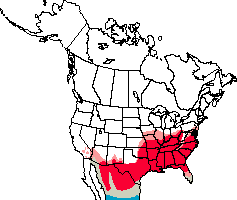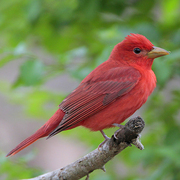Summer Tanager
Piranga
rubra
Passeriformes
Members of this diverse group make up more than half of the bird species worldwide. Most are small. However their brains are relatively large and their learning abilities are greater than those of most other birds. Passerine birds are divided into two suborders, the suboscines and the oscines. Oscines are capable of more complex song, and are considered the true songbirds. In Washington, the tyrant flycatchers are the only suboscines; the remaining 27 families are oscines.
Thraupidae
The tanagers are a large and diverse New World family with most members in the tropics. They are medium-sized birds with stout, generalized bills that allow them to eat both fruit and insects. Tanagers in the tropics have a number of differences from tanagers in the northern temperate zone. Most tropical tanagers are monomorphic, that is, males and females look alike. Most tanagers of the temperate zone exhibit a great degree of sexual dimorphism—males are brightly colored, and females are usually drab. Tropical tanagers are non-migratory and often gather in large, dramatic, mixed flocks. Northern-breeding tanagers are migratory and generally solitary but occasionally gather in small groups, especially during migration. Tanagers are generally monogamous. Females build the nest and incubate the young, and both sexes help feed the young. Even with their bright plumage, tanagers can be difficult to see, as they inhabit the forest canopy.
General Description
One record, a bird visiting a Skagit County feeder in December-January.
North American Range Map





